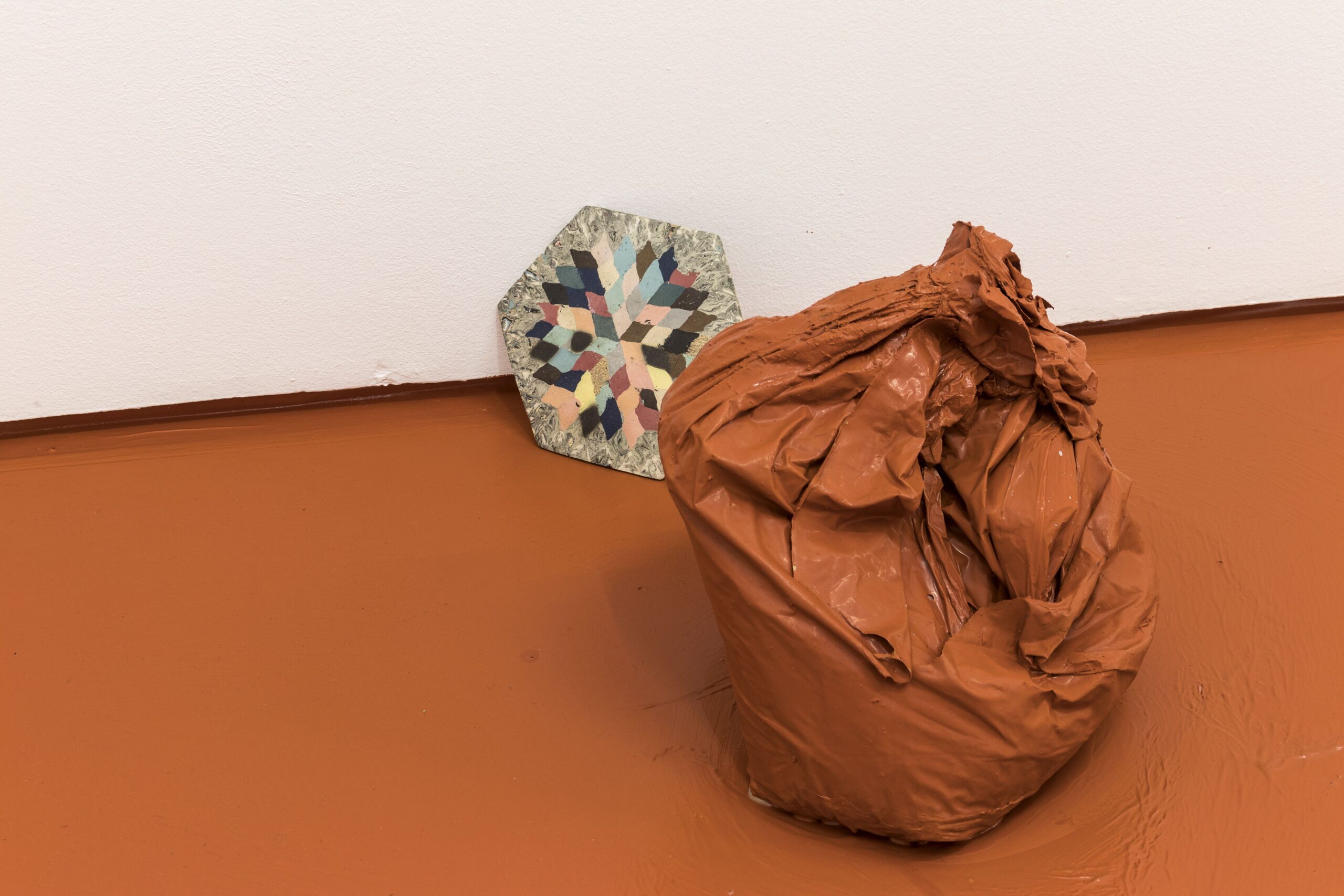Oh spider! Big spider! Do you bring the cure, spider? Hugo Canoilas and Antónia Labaredas
Unpublished review about the exhibition Oh spider! Big spider! Do you bring the cure, spider? with artists Hugo Canoilas and Antónia Labaredas at Galeria Quadrado Azul, Lisbon, March – May 2018.

Exhibition view, Oh spider! Big spider! Do you bring the cure, spider?, Hugo Canoilas and Antónia Labaredas. Quadrado Azul, Lisbon, 2018.
©João Ferro Martins. Courtesy by the artists and the gallery
Entering the space, we are overwhelmed by a sense of disaster, as if witnessing the aftermath of a flood, a mire of sludgy liquid. This site-specific installation sets up a dialogue between paintings by Hugo Canoilas and a new body of ceramic works by Antónia Labaredas. Objects of all kind (handles, locks, bolts, screws, pipes and string that recall domestic surroundings) are dispersed like relics of a “still life” (or rather “still death”). The brownish monochrome that conceals the shapes recalls a battle-field laid to waste by the passage of water, leaving a frozen scenario with a lunar atmosphere. Nonetheless, the title of the first painting is Il Trionfo della Morte, prominently written on the back of the canvas that faces us as we enter the space.
The meditation on a post-apocalyptic future, on the toxicity of a nuclear landscape, of these works provokes profound melancholy. The bright colours of the canvases and of the sculptures are the only hope of redemption.

Exhibition view, Oh spider! Big spider! Do you bring the cure, spider?, Hugo Canoilas and Antónia Labaredas. Quadrado Azul, Lisbon, 2018.
©João Ferro Martins. Courtesy by the artists and the gallery
Hugo Canoilas is not new to collaboration; in fact, for many years his studio in Vienna has been a shared space where ideas and materials could permeate. His paintings often become a framework hosting and accumulating different layers that draw on social, political and aesthetic considerations. “I do a lot of paintings and they always derive from this chaos. You have so many images in your head and some require expression, they push you in a certain direction.” [1] His colours float in the space in the same way that they emerge as a memory and deposit on the surface. The choice of hanging the canvases without backing avoids the rigid imposition of the wall and breaks with the orthogonal setting imposed by a rational and hierarchical system. “I started to hang unstretched canvases because they retain movement.”[2] The figurative images act as a sort of grid, that may lead the eye of the observer, but ready to be destroyed.
The smooth layer of latex which covers the gallery rooms functions like a huge eraser, while not completely concealing the materiality and recognisability of the objects it encounters. We can still discern traces, we can still perceive the shadows. This reminds us of the world from which we come, like an imminent nostalgia: a shapeless mass where the objects are nameless and the substances do not differ.

Exhibition view, Oh spider! Big spider! Do you bring the cure, spider?, Hugo Canoilas and Antónia Labaredas. Quadrado Azul, Lisbon, 2018.
©João Ferro Martins. Courtesy by the artists and the gallery
A spider under a transparent wine glass, placed on a shelf, opens the show like an admonishment. This is the only organic living presence that hints at metaphorical cobwebs, suggesting the canvas is a weave with its redemptive/horrific power.
Antónia Labaredas’ ceramics are metamorphic presences, resembling big shells or fossils or primordial artisanal goods, abandoned on the ground. Their forms create multiple correspondences with the subjects of the canvases, in which the same organic forms seem to appear.

Exhibition view, Oh spider! Big spider! Do you bring the cure, spider?, Hugo Canoilas and Antónia Labaredas. Quadrado Azul, Lisbon, 2018.
©João Ferro Martins. Courtesy by the artists and the gallery
I believe the artists, either consciously or unconsciously, did not really dissemble these scenographic tricks. The exhibition is staged, the spectators sometimes disengage from its spell by averting their gaze to the plastic sheeting on the floor, that appears ready to be folded up and taken away as trash. Canoilas’ paintings need this display due to their environmental dimension and their strong aerial presence, whereas Labaredas’ sculptures stand as vectors which address your attention, thus ensuring the overall effectiveness of the exhibition.
